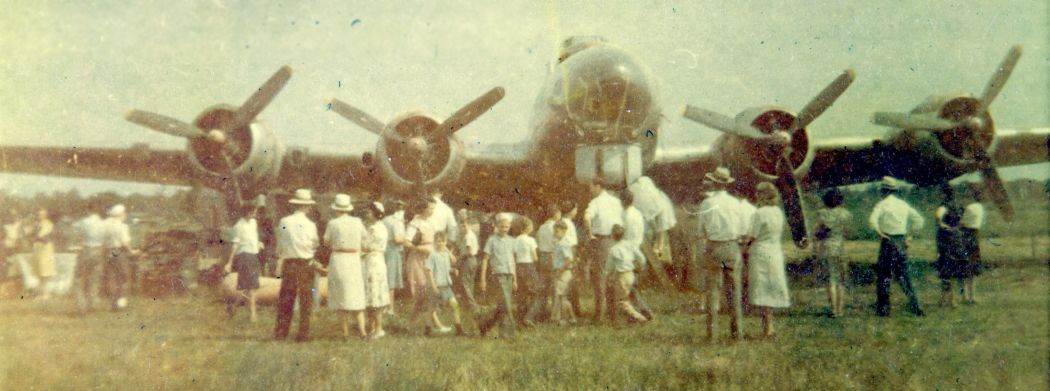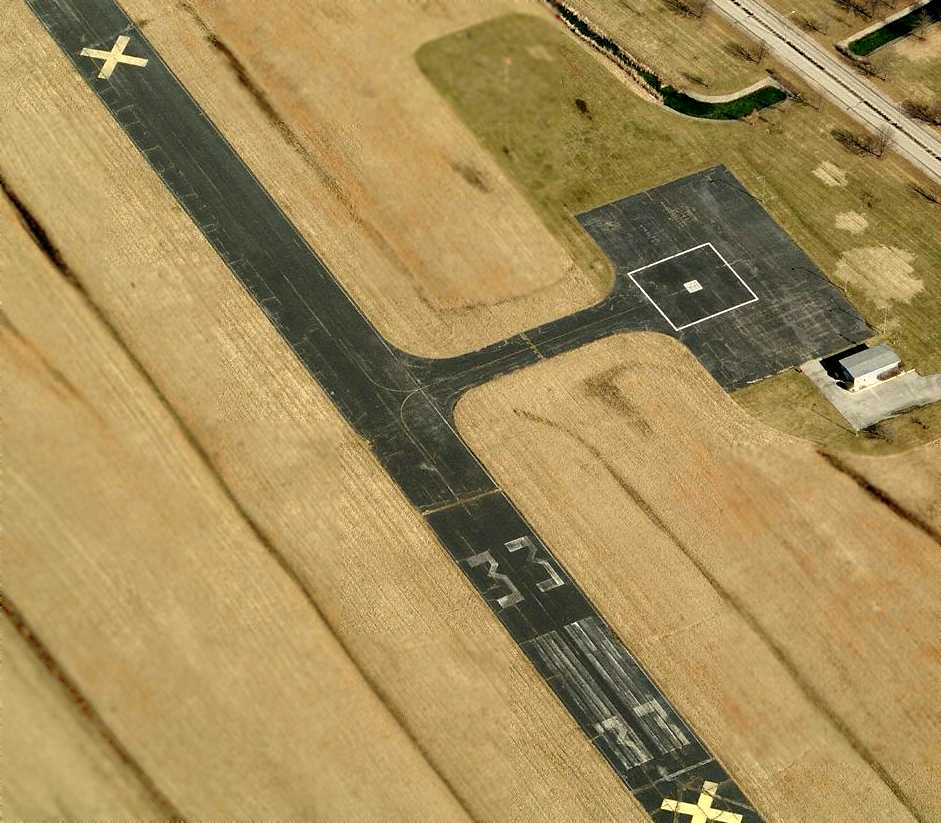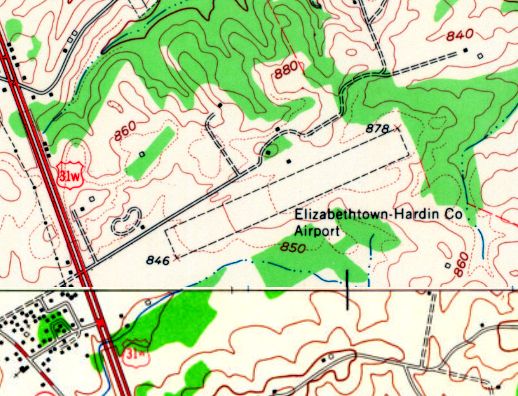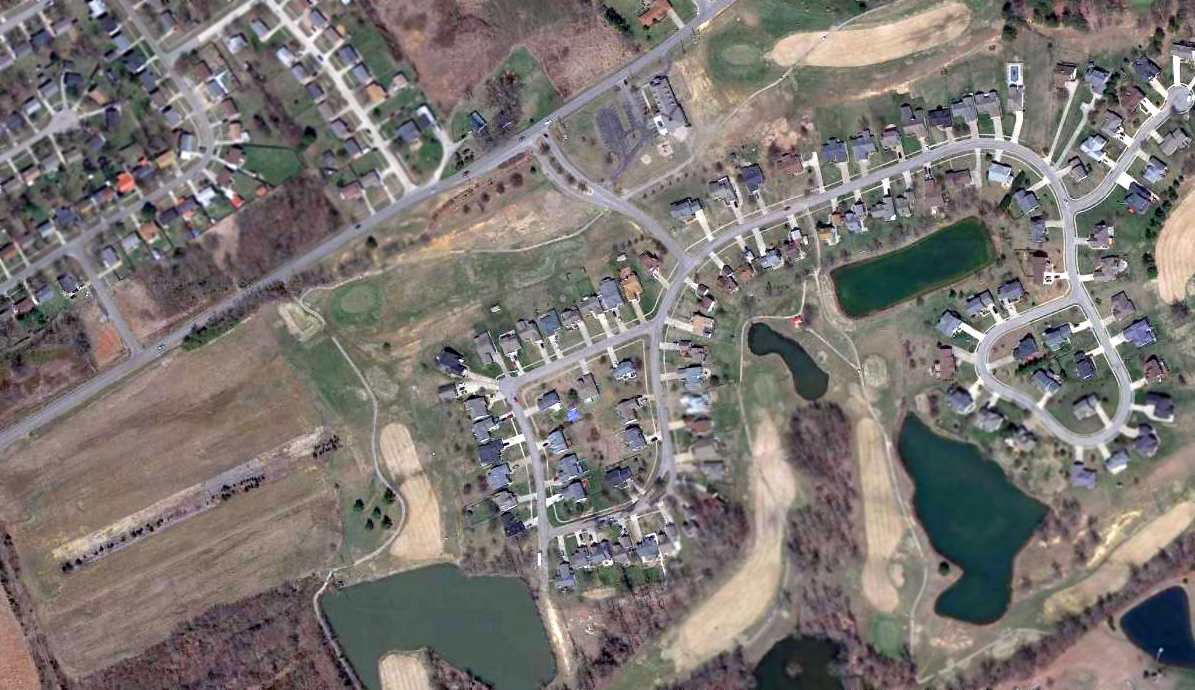
Abandoned & Little-Known Airfields:
Western Kentucky
© 2003, © 2016 by Paul Freeman. Revised 10/27/16.
This site covers airfields in all 50 states: Click here for the site's main menu.
____________________________________________________
Please consider a financial contribution to support the continued growth & operation of this site.
Breckenridge AAF / Morganfield Airport (revised 6/8/16) – Original Hancock County Airport (revised 3/2/14)
Hardin County / Elizabethtown Airport (revised 8/12/15) - Howell Field (revised 10/27/16)
____________________________________________________
37.09, -86.67 (Southwest of Louisville, KY)

A 11/3/43 aerial view looking north at Howell Field from the 1945 AAF Airfield Directory (courtesy of Scott Murdock).
According to the program for the 1949 rededication of Barkley Field (courtesy of Christopher Brame),
"In 1932 the city acquired its first municipal airfield.
Congress had allocated limited funds to improve city airports, as part of the old civil works relief program.
Local fliers & civic leaders obtained some of those funds.
A 55-acre tract on the Coleman Road was chosen & Mayor E. G. Scott's administration bought the ground for $1,200
and obtained about $6,000 in federal funds to improve it.
Richard LeRoy was a supervisor on the project.
The field gave good service from 1932 on, a number of bang-up pilots having controlled it at various times."
The earliest depiction of which has been located of Howell Field
was a 11/3/43 aerial view from the 1945 AAF Airfield Directory (courtesy of Scott Murdock).
It depicted Howell Field as consisting of an irregularly-shaped grass airfield with a single hangar on the east side.
According to the program for the 1949 rededication of Barkley Field (courtesy of Christopher Brame),
"The field... was sold by the city in 1944 to Dexter Howell.”

A 1945 photo (courtesy of Christopher Brame) of a surplus Boeing B-17G bomber at Howell Field.
Christopher reported, “My dad was in the Air Scouts just after the war & they had a B-17G.”

A circa 1945 photo (courtesy of Christopher Brame) of a variety of single-engine taildraggers at Howell Field.
The 1945 AAF Airfield Directory (courtesy of Scott Murdock) described Howell Field
as a 55 acre irregularly-shaped property having an all-way sod landing area measuring 2,100' northwest/southeast.
Howell was said to have a single 60' square metal hangar,
and to be owned & operated by private interests.

An announcement from the 6/9/46 Paducah Sun-Democrat (courtesy of Christopher Brame) about the display of a Boeing B-17 bomber at Howell Field.

A photo from the 6/9/46 Paducah Sun-Democrat (courtesy of Christopher Brame) of the Boeing B-17G bomber on display at Howell Field.

An advertisement for the Paducah Flying Service from the 6/23/46 Paducah Sun-Democrat (courtesy of Christopher Brame).
According to the program for the 1949 rededication of Barkley Field (courtesy of Christopher Brame),
"The field is still operated & is now leased by Dan Rush for charter service."
According to Christopher Brame, the Air Scout's B-17G at Howell Field “was scrapped around 1950.”

The 1949 USGS topo map depicted Howell Field as commercial/municipal airport.

A 2/21/52 USGS aerial photo appeared to show Howell Field as having been closed, with rows of several dozen trailers or other objects stored on the field near the hangar,
and no sign of any aviation use.

The 1958 USGS topo map depicted Howell Field as having a single unpaved northwest/southeast runway,
with a few small buildings on the east side.
According to Christopher Brame, Howell Field “was closed sometime in the 1950s or 1960s.”
A 1993 USGS aerial view showed the hangar had been removed at some point between 1952-93.

A 2013 aerial view showed no trace remaining of Howell Field.
The site of Howell Field is located west of the intersection of Coleman Road & Charter Oaks Drive.
Thanks to Christopher Brame for pointing out this airfield.
____________________________________________________
Original Hancock County Airport (X6M5), Petri, KY
37.94, -86.79 (Southwest of Louisville, KY)

Hancock County Airport, as depicted on the 1974 USGS topo map.
This general aviation airport was evidently established at some point between 1972-74,
as it was not yet depicted on the 1972 USGS topo map.
The earliest depiction of Hancock County Airport which has been located was on the 1974 USGS topo map.

The 1980 USGS topo map depicted “Hancock Field” as having a single paved northwest/southeast runway,
with a taxiway leading to a single small ramp with a single small building on the northwest side.

Hancock County Airport had evidently been closed by 1998,
as a 4/11/98 USGS aerial view looking southeast depicted the runway as being painted with 6 closed-runway “X” symbols.
A small ramp had been added on the southeast side, with what appeared to be a helipad.
In 2007 a replacement Hancock County Airport, Ron Lewis Field, was opened a few miles to the northwest.

A January 2009 aerial view by Bob Trader (courtesy of Phil Brooks) looking east at the runway of the former Hancock County Airport,
showing the plant in the background.
As of 2009, the owner of the “Hancock Airfield Airport” was listed as the National Southwire Aluminum Company,
and a street map labeled the property as “Lamar Field”.

A circa 2010 aerial view looking north at the ramp & runway which remain at the former Hancock County Airport

A 10/7/13 aerial view looking southeast showed the former Hancock County Airport remaining in fine condition.
The site of Hancock County Airport is located northwest of the intersection of Route 271 & Hawkesville Hancock Airfield Drive.
Thanks to Jamie Winner for pointing out this airfield.
____________________________________________________
Hardin County Airport / Elizabethtown Airport / Ben Floyd Airport (O19), Elizabethtown, KY
37.75 North / 85.89 West (Northwest of Nashville, TN)

A 4/10/60 USGS aerial photo depicted the Hardin County Airport in the initial stages of construction.
This general aviation airport was built in 1960,
as a 4/10/60 USGS aerial view showed the property having been cleared for construction.

The 1960 USGS topo map depicted the Elizabethtown - Hardin County Airport as having a single unpaved northeast/southwest runway.

The earliest aeronautical chart depiction of Hardin County Airport which has been located
was on the December 1961 Nashville Sectional Chart (courtesy of Chris Kennedy).
Hardin County was depicted as having a 2,800' hard-surface runway.
The 1961 USGS topo map depicted the Elizabethtown – Hardin County Airport
as having a single unpaved northeast/southwest runway.

Elizabethtown Hardin County Airport,
as depicted on the January 1968 Nashville Sectional Chart (courtesy of Chris Kennedy).

The 1968 Flight Guide (courtesy of Robert Levittan) depicted Hardin County as having a single 2,800' paved Runway 7/25,
with a ramp with 2 small buildings on the north side of the field.
The 1971 Flight Guide (courtesy of Chris Kennedy) depicted Hardin County as having a single 2,800' paved Runway 7/25,
with a ramp with 3 buildings (hangars?) on the north side of the field.
The 1975 USGS topo map depicted the Elizabethtown – Hardin County Airport
as having a single paved northeast/southwest runway.
The field was apparently renamed Ben Floyd Field at some point between 1971-76,
as that is how it was listed in the 1976 AOPA Airport Directory (courtesy of Chris Kennedy).
It described the field as offering repairs, fuel, charter, and tiedowns.
The operator was listed as Elizabethtown Flying Service.

Floyd Field was still listed as an active airport in the 1979 Flight Guide (courtesy of Chris Kennedy).
The 1983 USGS topo map labeled it as Ben Floyd Airfield.
By the time of the 1986 Flight Guide (according to Chris Kennedy), Ben Floyd Field was no longer listed.
It had apparently been replaced by the new Addington Airport (just west of the town of Elizabethtown),
which was built with a longer runway.
The 1987 USGS topo map labeled it as “Ben Floyd Airfield (Abandoned)”.
A 1997 USGS aerial photo showed that the eastern half of the airport site had been covered by a new housing development,
with several new streets (Sunningdale Way & Turnberry Way) having been built over the runway.
However, the outline of a 1,000' portion of the western end of the runway remained intact.

A 4/4/13 aerial photo showed that a 1,000' portion of the western end of the Elizabethtown runway still remains intact.
The site of Elizabethtown Airport is located east of the intersection of Route 31 & Pine Valley Drive.
____________________________________________________
Breckenridge Army Airfield / Morganfield Airport, Morganfield, KY
37.69, -87.84 (Northwest of Nashville, TN)

Breckenridge AAF, as depicted on the June 1953 Nashville Sectional Chart (courtesy of Chris Kennedy).
This military airfield was located on the grounds of Camp Breckenridge.
According to "WW2 Sites in the US" by Richard Osborne,
Camp Breckenridge was built in 1942 as a training camp for infantry units up to division size.
No airfield at the Camp was depicted on the March 1944 Nashville Sectional Chart (according to Chris Kennedy),
although there was a large Danger Area depicted over the Camp (most likely due to live artillery fire).
According to Mark Rickert, “The camp's original airfield was the Sturgis Airport, [which] was disposed of after WWII.
In the late 1940s part of the 101st [Airborne Division] moved in & the lack of airfield became problematic for air airborne operations.”
The Camp Breckenridge Airfield was not yet depicted on the 1951 USGS topo map.
The earliest depiction of Breckenridge Army Airfield which has been located
was on the June 1953 Nashville Sectional Chart (courtesy of Chris Kennedy).
The Aerodromes table on the chart described the field as having 2 runways,
with the longest being a 1,500' unpaved strip.
According to "WW2 Sites in the US" by Richard Osborne,
Camp Breckenridge was used during 1954-63 as a training camp for the Kentucky National Guard.

A 4/11/56 USGS aerial photo depicted Breckenridge AAF as having an unpaved northwest/southeast runway.
There did not appear to be any hangars or other improvements.

Breckenridge AAF apparently gained a paved runway at some point between 1956-62,
as the June 1962 Nashville Sectional Chart (courtesy of Chris Kennedy)
described the field as having a single 2,700' bituminous runway.
It also said "Tower operates days July 1 through August 10."
According to "WW2 Sites in the US" by Richard Osborne,
National Guard use of Camp Breckenridge ended in 1963 & it was parceled out to various organizations,
including some portions which were reused as a Job Corps Camp.
The airfield apparently closed at the same point in 1963.

Breckenridge AAF was labeled "Aband arpt" on the January 1968 Nashville Sectional Chart (courtesy of Chris Kennedy).

A 3/4/68 USGS aerial photo depicted Breckenridge AAF as having a paved northwest/southeast runway, with a paved ramp on the southwest side.

The 1969 USGS topo map depicted Breckenridge AAF as a single paved northwest/southeast runway, labeled “Landing Strip”,
with a taxiway leading to a ramp & one small building on the west side.
No airfield at the location was listed in the 1971 Flight Guide (according to Chris Kennedy).
But the former Army Airfield was apparently reopened as a civil airport at some point between 1971-74,
as it was labeled "Morganfield" Airport on the 1974 USGS topo map.

Morganfield Airport, as depicted on the August 1976 CG-20 World Aeronautical Chart (courtesy of Chris Kennedy).
The 1976 AOPA Airport Directory (courtesy of Chris Kennedy) described Morganfield Airport
as having a single 2,700' asphalt Runway 12/30,
but described the field as unattended.
A Bituminous Surface Rehabilitation Project was carried out at Morganfield Airport in 1982,
with the Construction Inspection performed by Johnson, Depp & Quisenberry.
Morganfield Airport was still described in the same fashion in the "Low-Use" airports section
of the 1986 Flight Guide (according to Chris Kennedy).
The Morganfield Airport was owned by the City of Morganfield.
Morganfield was still depicted as an active airfield on the 1998 World Aeronautical Chart.

The Morganfield Airport apparently was closed (for reasons unknown) at some point within 1998,
as a 1998 USGS aerial view looking northeast clearly showed closed-runway "X" symbols along the runway.
A taxiway led to a small ramp along the west side of the field,
which contained a few small buildings (and appeared to be used for storage of trucks or trailers).

A 6/15/08 aerial view looking southeast at Morganfield Airport showed it to remain intact,
still with closed-runway "X" symbols along the runway.

A circa 2010 aerial view looking south at Morganfield Airport showed the Runway 12 markings to still remain recognizable.
Construction of some sort was situated on the former ramp.
Morganfield Airport is located southeast of the intersection of Route 60 & Route 2091.
____________________________________________________
Since this site was first put on the web in 1999, its popularity has grown tremendously.
That has caused it to often exceed bandwidth limitations
set by the company which I pay to host it on the web.
If the total quantity of material on this site is to continue to grow,
it will require ever-increasing funding to pay its expenses.
Therefore, I request financial contributions from site visitors,
to help defray the increasing costs of the site
and ensure that it continues to be available & to grow.
What would you pay for a good aviation magazine, or a good aviation book?
Please consider a donation of an equivalent amount, at the least.
This site is not supported by commercial advertising –
it is purely supported by donations.
If you enjoy the site, and would like to make a financial contribution,
you
may use a credit card via
![]() ,
using one of 2 methods:
,
using one of 2 methods:
To make a one-time donation of an amount of your choice:
Or you can sign up for a $10 monthly subscription to help support the site on an ongoing basis:
Or if you prefer to contact me directly concerning a contribution (for a mailing address to send a check),
please contact me at: paulandterryfreeman@gmail.com
If you enjoy this web site, please support it with a financial contribution.
please contact me at: paulandterryfreeman@gmail.com
If you enjoy this web site, please support it with a financial contribution.
____________________________________________________
This site covers airfields in all 50 states.